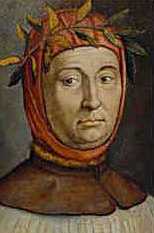
"Of all the world's great writers, Petrarch is the best known for losing his head. On Good Friday in 1327, the then 23-year-old writer and scholar fell madly - and forlornly - in love with a woman he saw in a church congregation.
His bad luck, to become enamored of a woman who did not return his affections, was the rest of humanity's good fortune. For, in seeking to express his feelings for the woman he called Laura, Francesco Petrarch gave definitive form to the sonnet and established himself as the first modern, western poet.
Now, it seems, he has lost his head for a second time.
Scientists who have been examining what they thought were Petrarch's remains have discovered that the skull belongs to someone else. And they suspect it could be that of a woman.
Professor Vito Terribile Wiel Marin of Padua University, who is heading the investigation, told the Guardian yesterday: "This must have been robbery. It is not, frankly, a nice business."
The suspects in a literary whodunnit spanning almost 700 years include a bibulously larcenous 17th century friar and a supposedly clumsy 19th century anatomist. Death has put both beyond the reach of indictment, but if Petrarch's skull were to be traced as a result of the latest discovery it could lead to charges of receiving stolen goods, an offense for which, under Italian law, there is no statute of limitations.
The seeds of the mystery were sown last November when a crane lifted the lid from Petrarch's pink marble tomb at Arquà Petrarca, the town where he died in 1374. It was the latest in a series of exhumations in Italy of famous historical figures. Prof Terribile Wiel Marin helped to set the vogue when he examined the remains of St Anthony of Padua in 1981.
One of the main reasons for picking over Petrarch's remains was to reconstruct his face and create a definitive portrait in time for the 700th anniversary of the poet's birth on July 20.
"Since we now don't even have his skull, that is absolutely impossible," Prof Terribile Wiel Marin lamented.
The bones of what was thought to be Petrarch's venerable head were in fragments when they were removed from his tomb. In 1873, it had been opened by an investigator, Professor Giovanni Canestrini, also at Padua University.
"He claimed Petrarch's skull disintegrated on contact with the air," said Prof Terribile Wiel Marin. "Since none of us has ever come across an instance of this happening, we can only conclude he dropped it."
Or might he have made up the whole story, putting back a damaged substitute and keeping for himself the head of a man revered as one of the fathers of the Renaissance?
It was when the skull's fragments found in Petrarch's tomb were reassembled that doubts surfaced about their true nature. Prof Terribile Wiel Marin said one of his team, Dr Maria Antonia Capitanio, noted the contours in two areas - above the eyes and below the ears - were more typical of a woman. Samples from a tooth and a rib were sent for analysis by Dr David Caramelli, a molecular anthropologist at Florence University who compared fragments of their DNA.
Last Friday, he reported back his sensational findings. "I am sure that the two samples are from different people," Dr Caramelli said yesterday..."
No comments:
Post a Comment